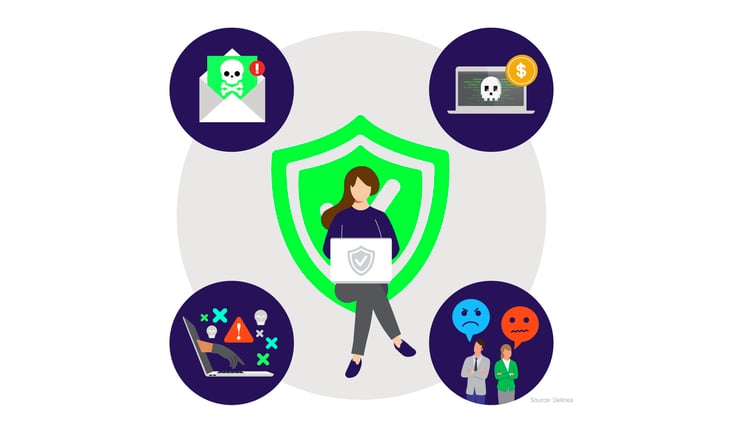Securing your business: Ransomware protection best practices
As the cybersecurity arms race rages on, ransomware has emerged as a formidable adversary for organizations of all sizes.
These malicious attacks can cripple businesses, compromise sensitive data, and lead to severe financial losses. As the frequency and sophistication of ransomware attacks continue to rise, it is imperative for organizations to proactively implement robust cybersecurity measures to safeguard their digital assets.

Ransomware attacks have evolved from isolated IT security incidents into full-blown business crises. In the past, a company's IT and security teams could handle a ransomware attack internally as just another cyber threat. But today's ransomware is much more sophisticated, aggressive, and disruptive to business operations. As a result, ransomware must be handled differently from other types of IT incidents.
Every company needs to know and implement ransomware protection best practices, no matter the size, industry, or location. Putting anti-ransomware tactics in place is critical to surviving common attacks, reducing costs, and maintaining trust in your business.
In this blog, we’ll cover foundational ransomware security practices as well as evolving strategies organizations are adopting to keep pace with cyber criminals.
Fundamental strategies and best practices for ransomware protection
Think of ransomware protection best practices in four categories: prevention, detection, response, and resilience. Each one has associated tools and tactics.
1. Prevention
Preventing and mitigating ransomware is all about addressing as many weaknesses in your attack surface as possible.
The primary best practice to reduce the risk of becoming a ransomware victim is to adopt a zero-trust strategy. That means ensuring that identities and access associated with every user, application, script, and system in your organization has the least number of privileges to perform their job. This is typically known as the principle of least privilege and is a major step on the journey to adapting to a zero-trust framework.
That way, even if an attacker were to steal credentials and gain initial entry, you’ve blocked their movements, and the damage they can do will be limited.
Many ransomware attacks enter an enterprise IT environment through user credentials and workstations. In a typical scenario, a user clicks on a link included in a phishing email and unwittingly downloads malware.
To reduce the risk of this scenario, ransomware protection best practice is to remove or disable local privileged accounts from workstations and limit which applications and scripts can execute using allow and deny lists. Or, use reputation feeds to determine if an application is known as malicious.
In addition to Privileged Access Management (PAM) best practices like those listed above, make sure you're patching systems with the latest updates to help reduce the risk of ransomware.
Ransomware prevention isn’t just the job of the IT or security teams. Rather, everyone in an organization must understand security best practices to prevent ransomware. For example, security awareness training helps people recognize the red flags of phishing emails, so they don’t click on those links to begin with!
2. Detection
Let’s say an attacker finds a stealthy way to circumvent your ransomware protections, even though you’ve followed all the best practices. How will you detect them? You don’t want to find out when you receive the ransomware demand.
Know the warning signs that ransomware is in your environment.
- Tools like User and Entity Behavior Analytics (UEBA) and privileged analytics can signal you of anomalous user behavior.
- You might begin to see systems slow down or struggle (even if they don’t shut down).
- Track how data is moving through your systems, especially when it’s leaving your environment. Now that attackers are focusing on data exfiltration , this is especially important.
3. Response
Once you believe you’ve detected ransomware, the faster you respond, the more likely you are to shut down an attack and contain the damage.
For example, if you’re using application controls and you suspect an application or script is malicious, you can sandbox it to evaluate it further or check its reputation, such as using integrations with solutions such as VirusTotal.
If you determine that privileged user behavior is happening outside of normal bounds, you could immediately make Multi-factor authentication (MFA) requirements stricter, rotate credentials, or even remove access.
A critical ransomware protection best practice many companies skip is documenting how you will respond to a ransomware attack. Create a cyber incident response plan and orchestrate some dry runs so you can avoid confusion and delays.
4. Resilience
The last category of ransomware protection best practices—resilience—is arguably the most important and, for some companies, the most difficult to achieve. Resilience means that even if you become the victim of a ransomware attack, you’ll survive.
Maintaining regular backups can prevent data loss in the case of a ransomware attack and is key to cyber resilience. If you can identify exactly when and where a ransomware attack occurred, then you can then recover data from that point without worrying about reinserting malware into your systems.
Keep in mind that cyber criminals are increasingly targeting backups, so best practice here is to retain data in multiple locations.
In addition to security tools and practices, cyber insurance has become a best practice companies need in place. Cyber insurance transfers the financial risk of a ransomware attack, like a safety net. As long as you’re following the ransomware protection best practices insurance companies require, you’ll likely be able to recover the damages of an attack.
Ransomware practices depend on what you’re trying to protect
As ransomware attack strategies evolve, so does advice about ransomware protection best practices.
Beyond the fundamental ransomware best practices described above, you’ll want to double down on defenses that fit your specific IT environment. Which practices you follow can depend on your industry and business processes. For example, a healthcare organization with PII may follow different ransomware practices than a private company in a non-regulated industry.
Think about your most valuable assets. Which attack scenarios would cause your operations to shut down? Which would most negatively impact your customers? Those are the ones you’ll want to prioritize when it comes to ransomware protection.
Most enterprises we work with pay close attention to certain areas of their IT environment to protect themselves from ransomware.
Cloud data and infrastructure
In the past, ransomware attackers targeted on-premise servers and local data. But the cloud is now a lucrative target. Cloud misconfigurations are rampant, which provides an entry point for ransomware attacks. Just as discussed above, maintaining access control over your cloud resources is an essential ransomware protection best practice.
Remote workers and remote access
RDP is a popular intrusion vector for ransomware attacks. If you have employees working from home or third-party contractors logging into your systems, implement secure remote access that limits and audits their privileged behavior.
Code and APIs
Cyber criminals often find credentials left in code stored in repositories like Github. As a ransomware protection best practice, make sure you always change default credentials and remove them from systems (including test and production.
Machine identities / service accounts
If you have machine identities and service accounts, you may struggle with ransomware detection and response. Attackers are stealthy, and systems without human oversight can easily be overlooked. Make sure you know the dependencies and how to change credentials or shut down services if necessary.
Below is a list of Ransomware Protections to help reduce the risks and increase your business resiliency against ransomware attacks
- Educate and train employees: One of the primary entry points for ransomware attacks is through phishing emails and social engineering tactics. Educating employees on recognizing and avoiding suspicious emails, links, and attachments is crucial. Conduct regular training sessions to keep your staff informed about the latest threats and reinforce the importance of following security protocols.
- Implement a multi-layered security approach: Relying on a single security measure is insufficient in today's threat landscape. Implement a multi-layered security strategy that includes firewalls, antivirus software, intrusion detection systems, and email filtering. Regularly update and patch all software to address vulnerabilities that could be exploited by ransomware.
- Back up data regularly: Regularly backing up critical data is a fundamental aspect of ransomware preparedness. Ensure that backups are stored securely, preferably offline, to prevent them from being compromised in the event of an attack. Test the backup and restoration processes periodically to guarantee their effectiveness.
- Employ endpoint protection: Endpoint protection solutions help secure individual devices such as computers, laptops, and mobile devices. These solutions often include features like advanced threat detection, behavioral analysis, and application whitelisting, providing an additional layer of defense against ransomware.
- Network segmentation: Segregate your network into different segments to contain and minimize the impact of a ransomware attack. This can prevent the lateral movement of malware within the network and limit the scope of the infection, making it easier to detect and mitigate.
- Regularly update and patch systems: Outdated software and unpatched systems are prime targets for ransomware attacks. Establish a robust patch management process to ensure that all software and systems are up to date with the latest security patches. This reduces the attack surface and strengthens your organization's defenses.
- Implement least privilege access: Limit user access to the minimum level necessary for their job responsibilities. By implementing the principle of least privilege, you reduce the risk of ransomware spreading laterally and accessing critical systems and data.
- Incident Response Plan: Develop a comprehensive incident response plan that outlines the steps to be taken in the event of a ransomware attack. This plan should include communication protocols, procedures for isolating affected systems, and coordination with law enforcement and cybersecurity experts.
- Regular security audits and assessments: Conduct regular security audits and assessments to identify and address vulnerabilities within your organization. This proactive approach helps you stay ahead of potential threats and enhances your overall cybersecurity posture.
- Collaborate with cybersecurity experts: Consider partnering with cybersecurity experts, consultants, or managed security service providers to stay abreast of the latest threats and leverage their expertise in fortifying your organization's defenses.
Protecting your organization from ransomware requires a comprehensive and proactive approach. By prioritizing cybersecurity education, implementing robust security measures, and staying vigilant against evolving threats, you can significantly reduce the risk of falling victim to ransomware attacks.
Remember, cybersecurity is an ongoing process, and adapting to new threats is essential for safeguarding your organization's digital assets in an increasingly interconnected world.
Looking for more ransomware protection best practices?
Download our free Ransomware Defense Toolkit from the link below, then check out our podcast playlist "Navigating the Ransomware Threat Landscape."

6-in-1 Toolkit for Ransomware Defense


